Signature of Tidal Sea Level in Geomagnetic Field Variations at Island Lampedusa (Italy) Observatory
Abstract
1. Introduction
2. Data and Methods
3. Experimental Results
3.1. Geomagnetic Effects of Tidal Modes at Lampedusa and Duronia Observatories
3.2. Transfer Functions and Single-Station Induction Arrows
3.3. Dependency of Transfer Functions on the Lunar O1 Tidal Mode Sea Level Change
- The geomagnetic field variations around the selected ith-epoch and for a time interval ±48 h are linearly detrended;
- The selected geomagnetic time series are Fourier analyzed by considering a 1/2 h moving time series (so the time resolution of dynamic spectra is 1/2 h) of a duration of 3 h spanning the ±48 h time interval. For each moving subset, we computed the auto-spectra and cross-spectra following Welch’s method, i.e., subdividing the 3 h time window into the 1 h time window with a 67% overlap;
- Around each time with respect to the zero epoch ( = 0), the transfer function coefficients are computed both in the amplitude and phase following Equations (4) and (5) by using 20 spectra and cross-spectra. This number of chosen spectra allows to reach reliable SSIA amplitudes and phases (in the least squares sense) and short time uncertainties.
4. Discussion
5. Conclusions
- 1.
- The tidal modes of the internal (oceanic) and external (ionospheric) sources are found at both sites and for both the solar and lunar gravitational forces, in agreement with past investigations.
- 2.
- Through a robust fit analysis of the geomagnetic field variations, and through a comparison between the nighttime and daytime data, it was evidenced that on the geomagnetic signature of the M2 barotropic tidal mode, the oceanic contribution is dominant at Lampedusa with respect to the ionospheric contribution, in agreement with other investigations on similar sites. On the contrary, at Duronia, which is an inland site, the ionospheric contribution is dominant both at daytime and nighttime.
- 3.
- The geomagnetic field variations investigated in the spectral domain through transfer functions clearly indicated a different response along the Z component at the two sites, which is reflected in the different behavior of the induction vectors. At DUR, a coast effect emerges, with arrows directed toward the Adriatic sea. At LMP, which is a small island, the coast effect is partially canceled due to the island geometry, with a residual toward the west due to the westernmost position of the observatory, and with the highest amplitude arrows pointing toward the surrounding regions with a higher conductivity in correspondence to a deeper ocean.
- 4.
- Through the Superposed Epoch Analysis applied to the O1 tidal mode, we found that the induction arrows at LMP are strongly correlated to sea level variations. Indeed, in correspondence to a sea level change of 1 cm, the transfer functions for frequencies f > 2 mHz (<1.3 mHz) show an increase of ∼ (∼) in the amplitude and ∼ (∼) in the phase.
Author Contributions
Funding
Institutional Review Board Statement
Informed Consent Statement
Data Availability Statement
Conflicts of Interest
Abbreviations
| CMEMS | Copernicus Marine Service |
| DUR | IAGA code for Duronia observatory |
| FFT | Fast Fourier Transform |
| GDS | Geomagnetic Depth Sounding |
| IAGA | International Association of Geomagnetism and Aeronomy |
| IRLS | Iteratively Re-weighted Least Squares |
| ISPRA | Istituto Superiore per la Protezione e la Ricerca Ambientale |
| LMP | IAGA code for Lampedusa observatory |
| LT | Local Time |
| NGDC | National Geophysical Data Center |
| NOAA | National Oceanic and Atmospheric Administration |
| PSD | Power Spectral Density |
| RMN | Rete Mareografica Nazionale |
| SE | Standard Error |
| SEA | Superposed Epoch Analysis |
| SEM | Standard Error of the Mean |
| SSIA | Single-Station Induction Arrow |
| ULF | Ultra-Low Frequency |
| UT | Universal Time |
References
- van Bemmelen, W. Die lunare Variation des Erdmagnetismus. Meteorol. Z. 1912, 29, 218–225. [Google Scholar]
- van Bemmelen, W. Berichtigung zu meiner Abhandlung über die lunare Variation des Erdmagnetismus. Meteorol. Z. 1913, 30, 589–594. [Google Scholar]
- Chapman, S.I. The solar and lunar diurnal variations of terrestrial magnetism. Philos. Trans. R. Soc. Lond. Ser. A Contain. Pap. Math. Phys. Character 1919, 218, 1–118. [Google Scholar] [CrossRef]
- Chapman, S.; Bartels, J. Geomagnetism, Vol. I and II; Oxford University Press: Oxford, UK, 1940. [Google Scholar]
- Matsushita, S.; Maeda, H. On the geomagnetic solar quiet daily variation field during the IGY. J. Geophys. Res. 1965, 70, 2535–2558. [Google Scholar] [CrossRef]
- Egedal, J. The lunar-diurnal magnetic variation and its relation to the solar-diurnal variation. J. Geophys. Res. 1956, 61, 748–749. [Google Scholar] [CrossRef]
- Larsen, J.C. Electric and Magnetic Fields Induced by Deep Sea Tides. Geophys. J. Int. 1968, 16, 47–70. [Google Scholar] [CrossRef]
- Schnepf, N.R.; Manoj, C.; Kuvshinov, A.; Toh, H.; Maus, S. Tidal signals in ocean-bottom magnetic measurements of the Northwestern Pacific: Observation versus prediction. Geophys. J. Int. 2014, 198, 1096–1110. [Google Scholar] [CrossRef][Green Version]
- Richmond, A. Modeling equatorial ionospheric electric fields. J. Atmos. Terr. Phys. 1995, 57, 1103–1115. [Google Scholar] [CrossRef]
- Kelley, M.C. The Earth’s Ionosphere, Plasma Physics and Electrodynamics, 2nd ed.; Academic Press, Inc.: San Diego, CA, USA, 1989; ISBN 9780120884254. [Google Scholar]
- Simpson, F.; Bahr, K. Practical Magnetotellurics; Cambridge University Press: Cambridge, UK, 2005; ISBN 9780511614095. [Google Scholar] [CrossRef]
- Berdichevsky, M.N.; Dmitriev, V.I. Models and Methods of Magnetotellurics; Springer: Berlin, Germany, 2008. [Google Scholar] [CrossRef]
- Parkinson, W.D. The Influence of Continents and Oceans on Geomagnetic Variations. Geophys. J. Int. 1962, 6, 441–449. [Google Scholar] [CrossRef]
- Parkinson, W.D. Directions of Rapid Geomagnetic Fluctuations. Geophys. J. Int. 1959, 2, 1–14. [Google Scholar] [CrossRef]
- Parkinson, W.D.; Jones, F.W. The geomagnetic coast effect. Rev. Geophys. 1979, 17, 1999. [Google Scholar] [CrossRef]
- Hitchman, A.P.; Milligan, P.R.; Lilley, F.T.; White, A.; Heinson, G.S. The total-field geomagnetic coast effect: The CICADA97 line from deep Tasman Sea to inland New South Wales. Explor. Geophys. 2000, 31, 52–57. [Google Scholar] [CrossRef]
- Armadillo, E.; Bozzo, E.; Cerv, V.; Santis, A.D.; Mauro, D.D.; Gambetta, M.; Meloni, A.; Pek, J.; Speranza, F. Geomagnetic depth sounding in the Northern Apennines (Italy). Earth Planets Space 2001, 53, 385–396. [Google Scholar] [CrossRef]
- Vujić, E.; Brkić, M. Geomagnetic coast effect at two Croatian repeat stations. Ann. Geophys. 2017, 59, G0652. [Google Scholar]
- Regi, M.; De Lauretis, M.; Francia, P.; Lepidi, S.; Piancatelli, A.; Urbini, S. The geomagnetic coast effect at two 80°S stations in Antarctica, observed in the ULF range. Ann. Geophys. 2018, 36, 193–203. [Google Scholar] [CrossRef]
- Samrock, F.; Kuvshinov, A. Tippers at island observatories: Can we use them to probe electrical conductivity of the Earth’s crust and upper mantle? Geophys. Res. Lett. 2013, 40, 824–828. [Google Scholar] [CrossRef]
- Morschhauser, A.; Grayver, A.; Kuvshinov, A.; Samrock, F.; Matzka, J. Tippers at island geomagnetic observatories constrain electrical conductivity of oceanic lithosphere and upper mantle. Earth Planets Space 2019, 71. [Google Scholar] [CrossRef]
- Di Mauro, D.; Regi, M.; Lepidi, S.; Del Corpo, A.; Dominici, G.; Bagiacchi, P.; Benedetti, G.; Cafarella, L. Geomagnetic Activity at Lampedusa Island: Characterization and Comparison with the Other Italian Observatories, Also in Response to Space Weather Events. Remote Sens. 2021, 13, 3111. [Google Scholar] [CrossRef]
- Amante, C.; Eakins, B.W. ETOPO1 1 Arc-Minute Global Relief Model: Procedures, Data Sources and Analysis. NOAA Technical Memorandum NESDIS NGDC-24. 2009. Available online: https://repository.library.noaa.gov/view/noaa/1163. https://www.ngdc.noaa.gov/mgg/global/relief/ETOPO1/docs/ETOPO1.pdf (accessed on 29 November 2022). [CrossRef]
- Pawlowicz, R. M_Map: A Mapping Package for MATLAB. 2020. Available online: http://www.eoas.ubc.ca/~rich/map.html (accessed on 29 November 2022).
- Civile, D.; Lodolo, E.; Tortorici, L.; Lanzafame, G.; Brancolini, G. Relationships between magmatism and tectonics in a continental rift: The Pantelleria Island region (Sicily Channel, Italy). Mar. Geol. 2008, 251, 32–46. [Google Scholar] [CrossRef]
- Civile, D.; Lodolo, E.; Alp, H.; Ben-Avraham, Z.; Cova, A.; Baradello, L.; Accettella, D.; Burca, M.; Centonze, J. Seismic stratigraphy and structural setting of the Adventure Plateau (Sicily Channel). Mar. Geophys. Res. 2013, 35, 37–53. [Google Scholar] [CrossRef]
- Regi, M.; Corpo, A.D.; De Lauretis, M. The use of the empirical mode decomposition for the identification of mean field aligned reference frames. Ann. Geophys. 2017, 59. [Google Scholar] [CrossRef]
- Thomson, D. Spectrum estimation and harmonic analysis. Proc. IEEE 1982, 70, 1055–1096. [Google Scholar] [CrossRef]
- Huber, P.J. Robust Statistics; Wiley Series in Probability and Statistics; Wiley: New York, NY, USA, 1981. [Google Scholar] [CrossRef]
- De Lauretis, M.; Francia, P.; Regi, M.; Villante, U.; Piancatelli, A. Pc3 pulsations in the polar cap and at low latitude. J. Geophys. Res. Space Phys. 2010, 115, A11223. [Google Scholar] [CrossRef]
- Everett, J.; Hyndman, R. Geomagnetic variations and electrical conductivity structure in south-western Australia. Phys. Earth Planet. Inter. 1967, 1, 24–34. [Google Scholar] [CrossRef]
- Francia, P.; Regi, M.; Lauretis, M.D.; Villante, U.; Pilipenko, V.A. A case study of upstream wave transmission to the ground at polar and low latitudes. J. Geophys. Res. Space Phys. 2012, 117. [Google Scholar] [CrossRef]
- Regi, M.; Francia, P.; De Lauretis, M.; Glassmeier, K.H.; Villante, U. Coherent transmission of upstream waves to polar latitudes through magnetotail lobes. J. Geophys. Res. Space Phys. 2013, 118, 6955–6963. [Google Scholar] [CrossRef]
- Regi, M.; De Lauretis, M.; Francia, P.; Villante, U. The propagation of ULF waves from the Earth’s foreshock region to ground: The case study of 15 February 2009. Earth Planets Space 2014, 66, 1–9. [Google Scholar] [CrossRef]
- Regi, M.; De Lauretis, M.; Francia, P. The occurrence of upstream waves in relation with the solar wind parameters: A statistical approach to estimate the size of the foreshock region. Planet. Space Sci. 2014, 90, 100–105. [Google Scholar] [CrossRef]
- Schmucker, U. Anomalies of Geomagnetic Variations in the Southwestern United States; Number 13 in Bull. Scripps Inst. Oceanography Univ. California; University of California Press: Berkeley, CA, USA, 1970; pp. 127–132. [Google Scholar]
- Wiese, H. Geomagnetische Tiefentellurik Teil II: Die Streichrichtung der untergrundstrukturen des elektrischen Widerstandes, erschlossen aus geomagnetischen Variationen. Geofis. Pura Appl. 1962, 52, 83–103. [Google Scholar] [CrossRef]
- Bendat, J.S.; Piersol, A.G. Random Data. Analysis and Measurement Procedures, 1st ed.; John Wiley & Sons: Hoboken, NY, USA, 1971. [Google Scholar]
- Regi, M.; De Lauretis, M.; Redaelli, G.; Francia, P. ULF geomagnetic and polar cap potential signatures in the temperature and zonal wind reanalysis data in Antarctica. J. Geophys. Res. Space Phys. 2016, 121, 286–295. [Google Scholar] [CrossRef]
- Jones, A. Geomagnetic Induction Studies in Scandinavia. II. Geomagnetic Depth Sounding, Induction Vectors and Coast-Effect. J. Geophys. 1981, 50, 23–36. [Google Scholar]
- McDougal, T.J.; Barker, P.M. Getting started with TEOS-10 and the Gibbs Seawater (GSW) Oceanographic Toolbox; Trevor J. McDougall. 2011. Available online: http://www.teos-10.org/software.htm (accessed on 29 November 2022).
- IOC; SOR; IAPSO. The international thermodynamic equations of seawater-2010: Calculation and use of thermodynamic properties. Intergov. Oceanogr. Comm. Manuals Guid. 2010, 56, 196. [Google Scholar]
- Simoncelli, S.; Masina, S.; Axell, L.; Liu, Y.; Salon, S.; Cossarini, G. MyOcean Regional Reanalyses: Overview of Reanalyses Systems and Main Results. Mercat. Ocean J. 2016, 54, 116. Available online: https://www.mercator-ocean.eu/wp-content/uploads/2016/03/JournalMO-54.pdf (accessed on 29 November 2022).
- Simoncelli, S.; Fratianni, C.; Pinardi, N.; Grandi, A.; Drudi, M.; Oddo, P.; Srdjan, D. Mediterranean Sea physical reanalysis (MEDREA). Copernic. Monit. Environ. Mar. Serv. (CMEMS) 2019. [Google Scholar] [CrossRef]
- Tyler, R.H.; Boyer, T.P.; Minami, T.; Zweng, M.M.; Reagan, J.R. Electrical conductivity of the global ocean. Earth Planets Space 2017, 69, 1–10. [Google Scholar] [CrossRef]
- Santarelli, L.; Palangio, P.; Lauretis, M.D. Electromagnetic background noise at L’Aquila Geomagnetic Observatory. Ann. Geophys. 2014, 57, G0211. [Google Scholar] [CrossRef]
- Jouini, M.; Béranger, K.; Arsouze, T.; Beuvier, J.; Thiria, S.; Crépon, M.; Taupier-Letage, I. The Sicily Channel surface circulation revisited using a neural clustering analysis of a high-resolution simulation. J. Geophys. Res. Ocean. 2016, 121, 4545–4567. [Google Scholar] [CrossRef]
- Laken, B.A.; Čalogović, J. Composite analysis with Monte Carlo methods: An example with cosmic rays and clouds. J. Space Weather. Space Clim. 2013, 3, A29:1–A29:13. [Google Scholar] [CrossRef]
- Regi, M.; Redaelli, G.; Francia, P.; De Lauretis, M. ULF geomagnetic activity effects on tropospheric temperature, specific humidity, and cloud cover in Antarctica, during 2003–2010. J. Geophys. Res. Atmos. 2017, 122, 6488–6501. [Google Scholar] [CrossRef]
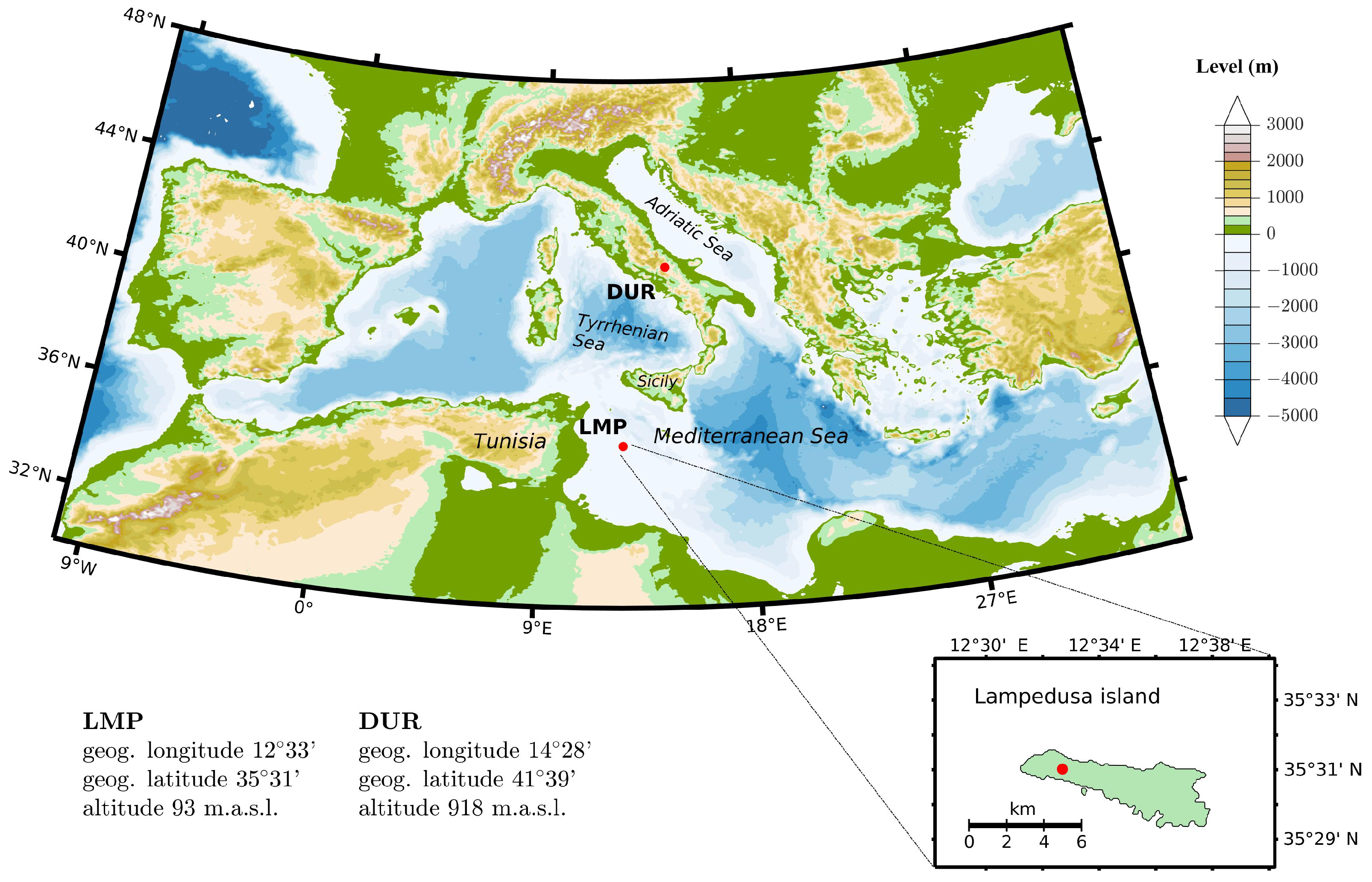
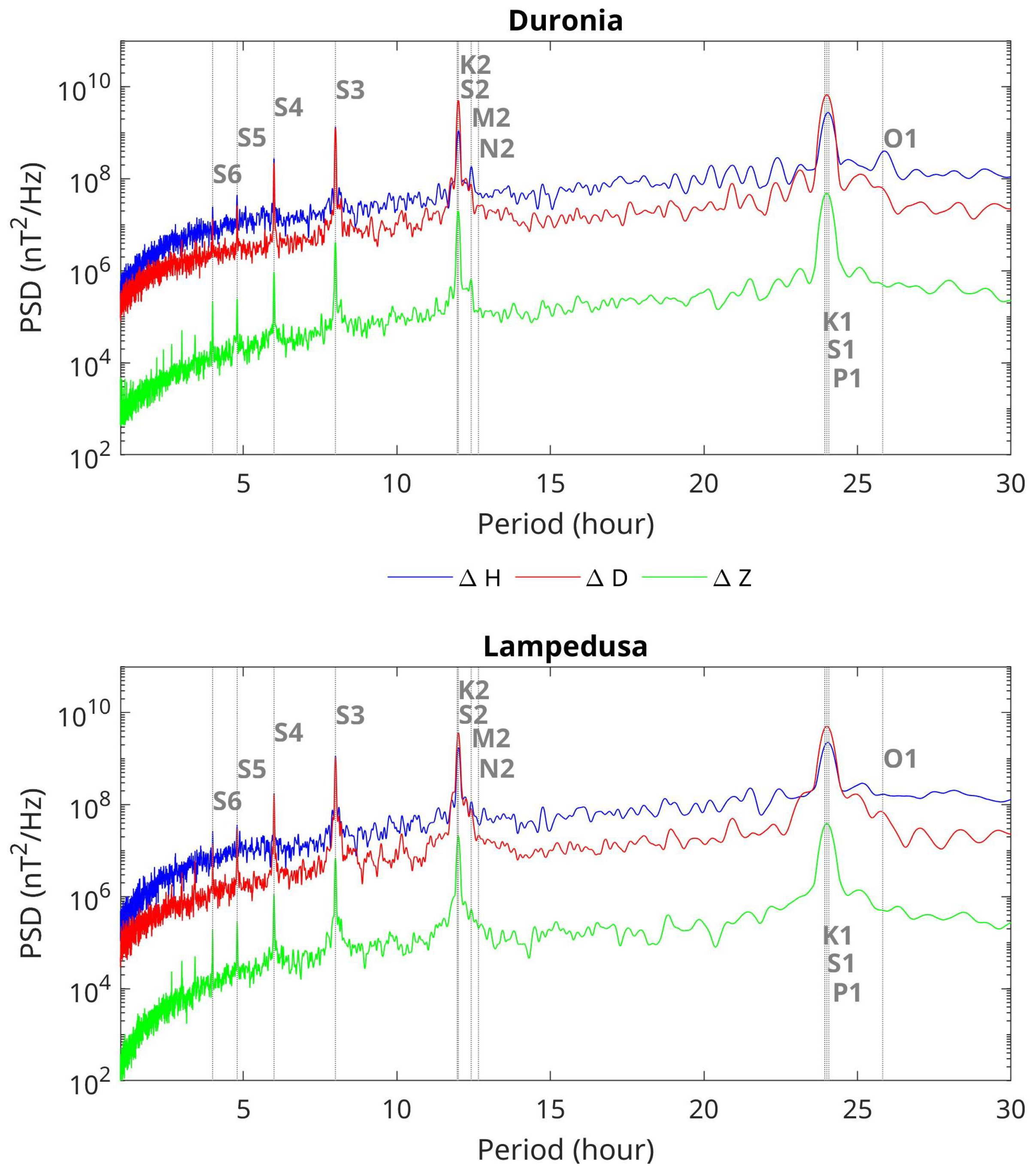
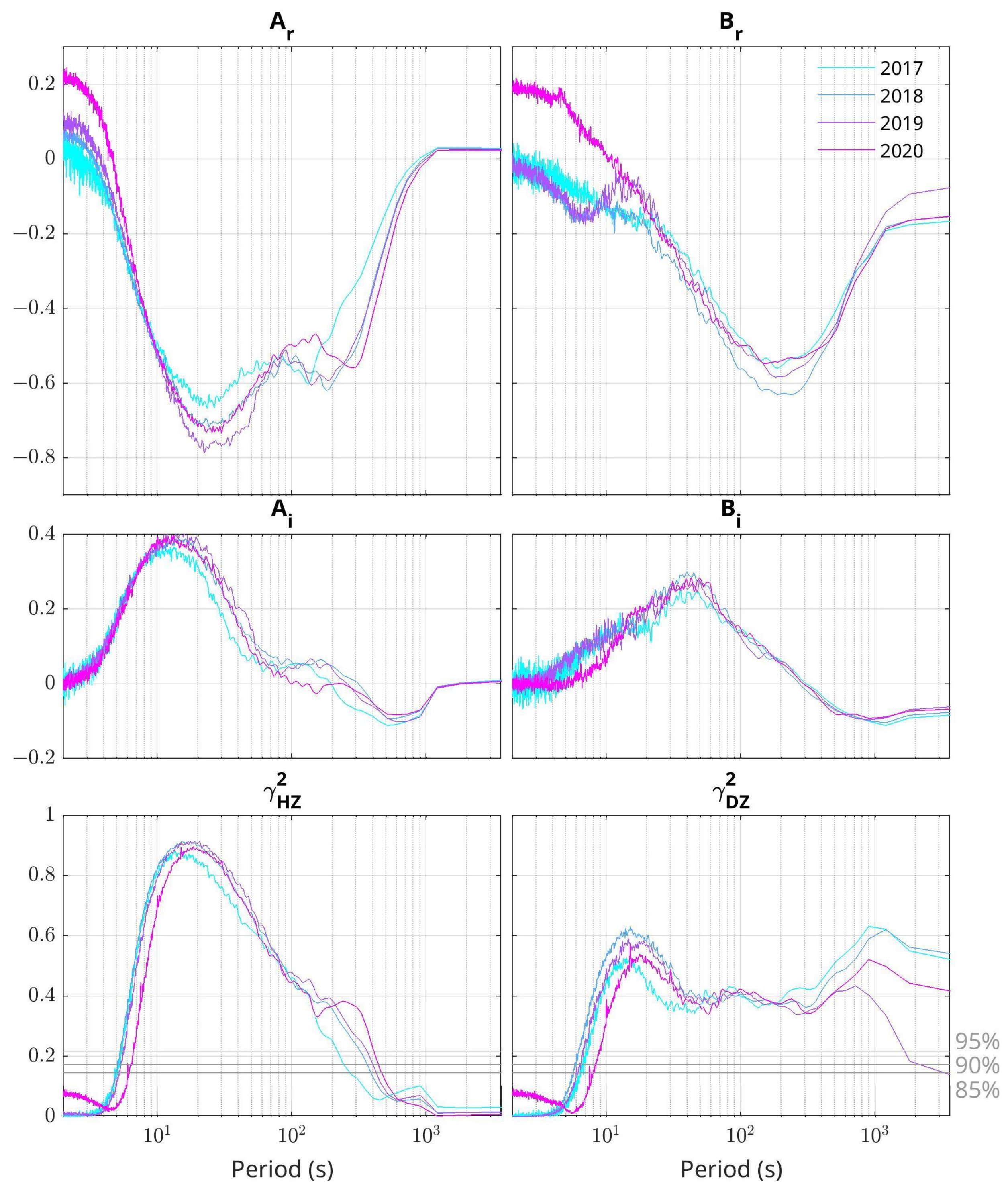
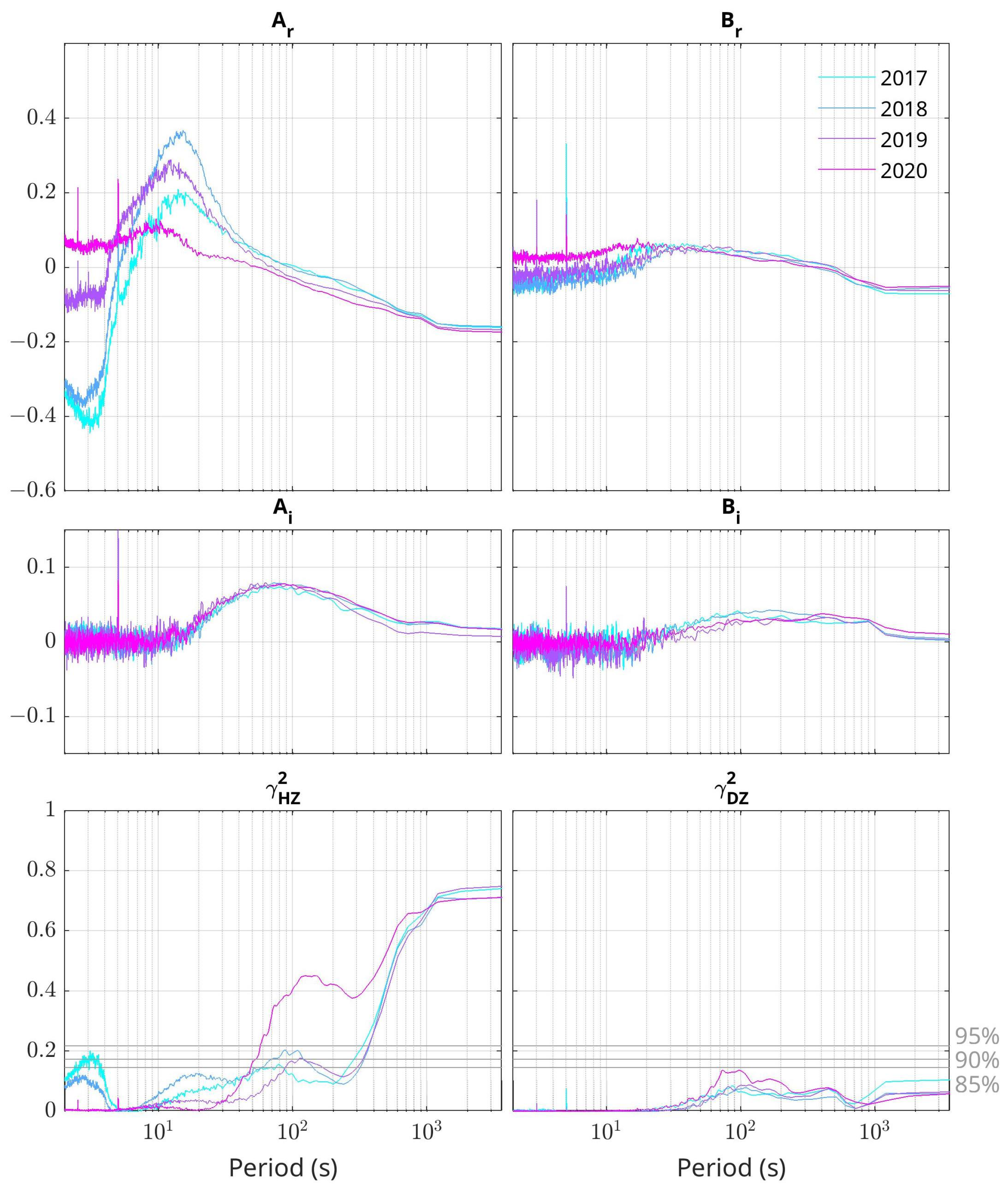
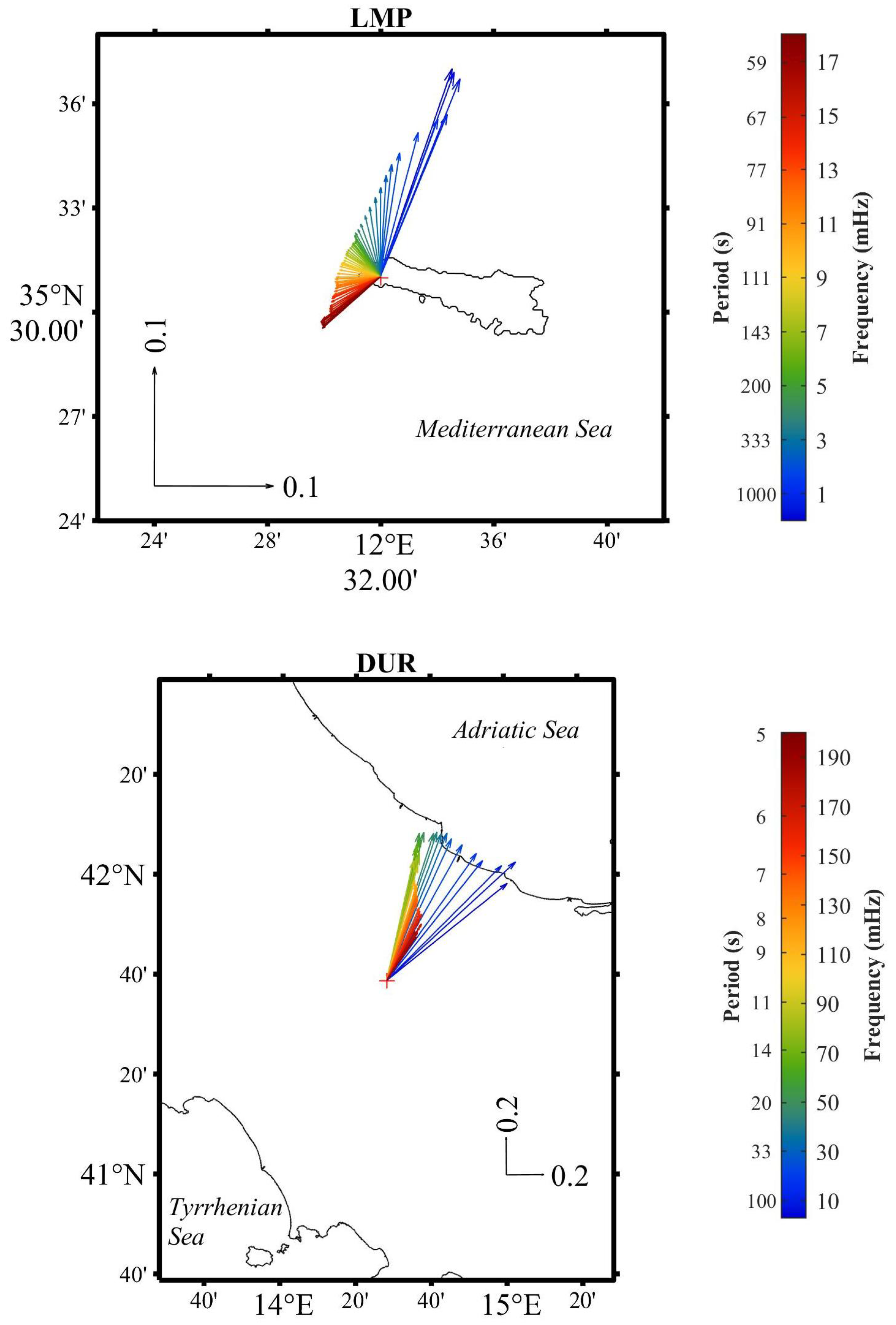
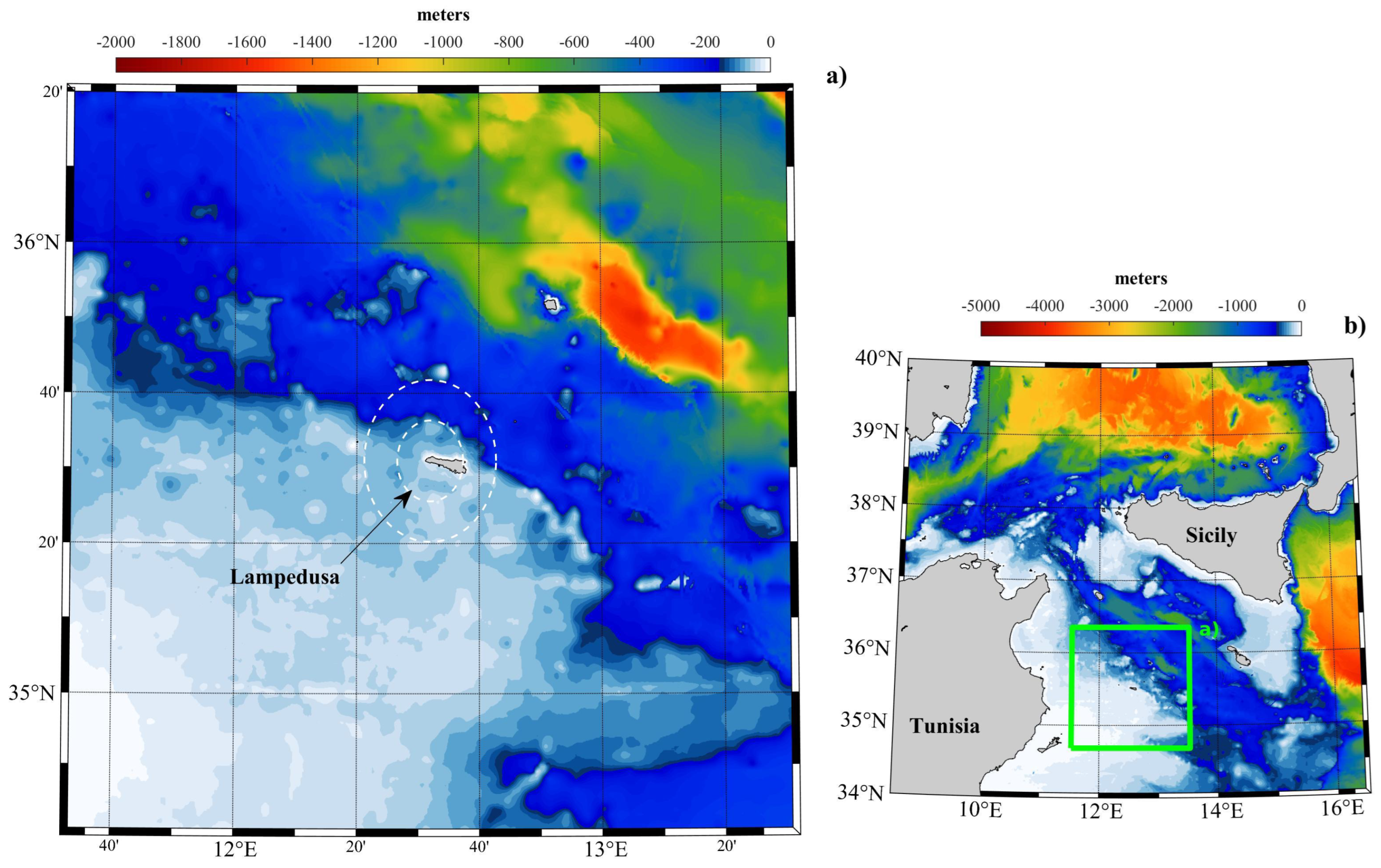
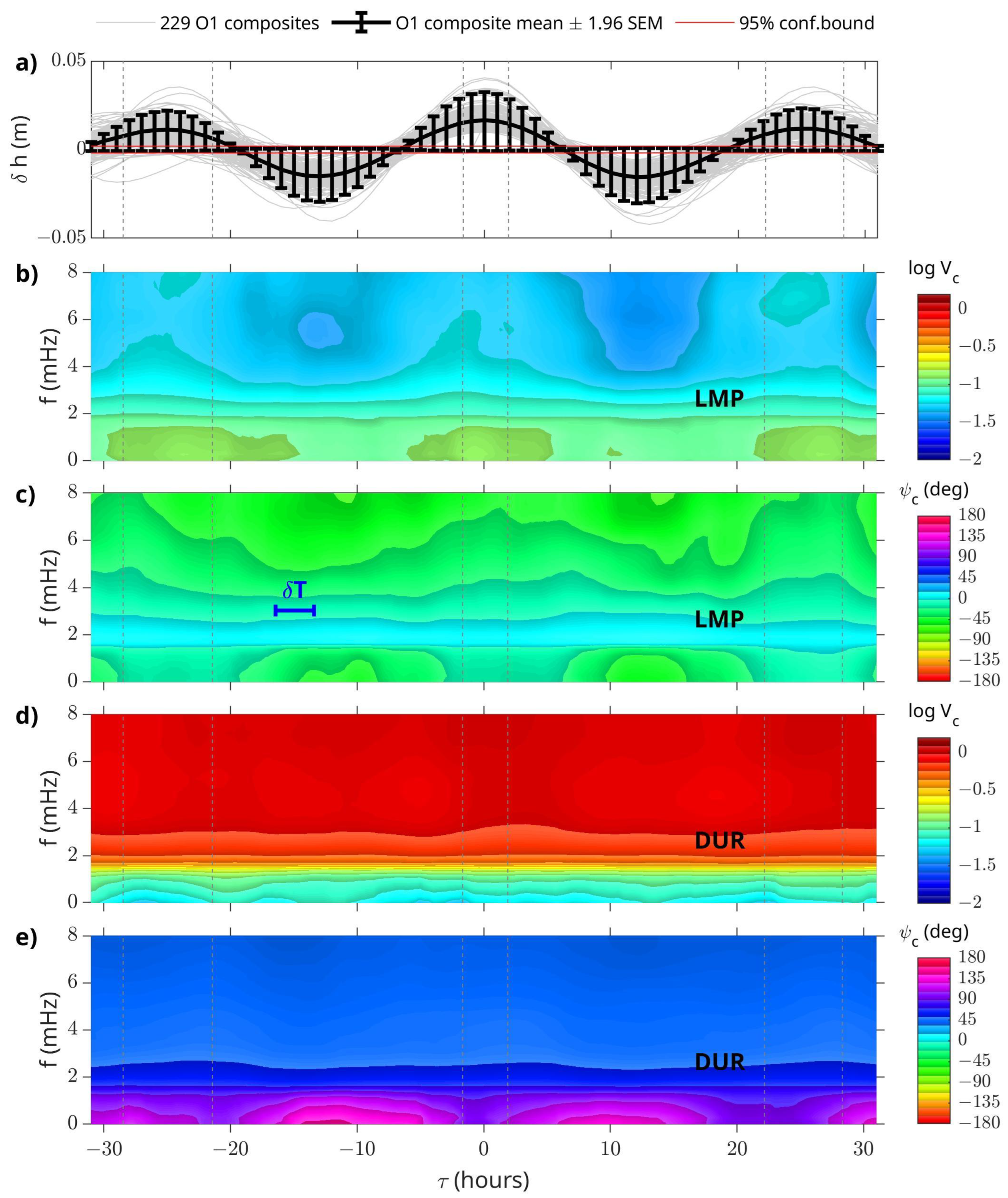
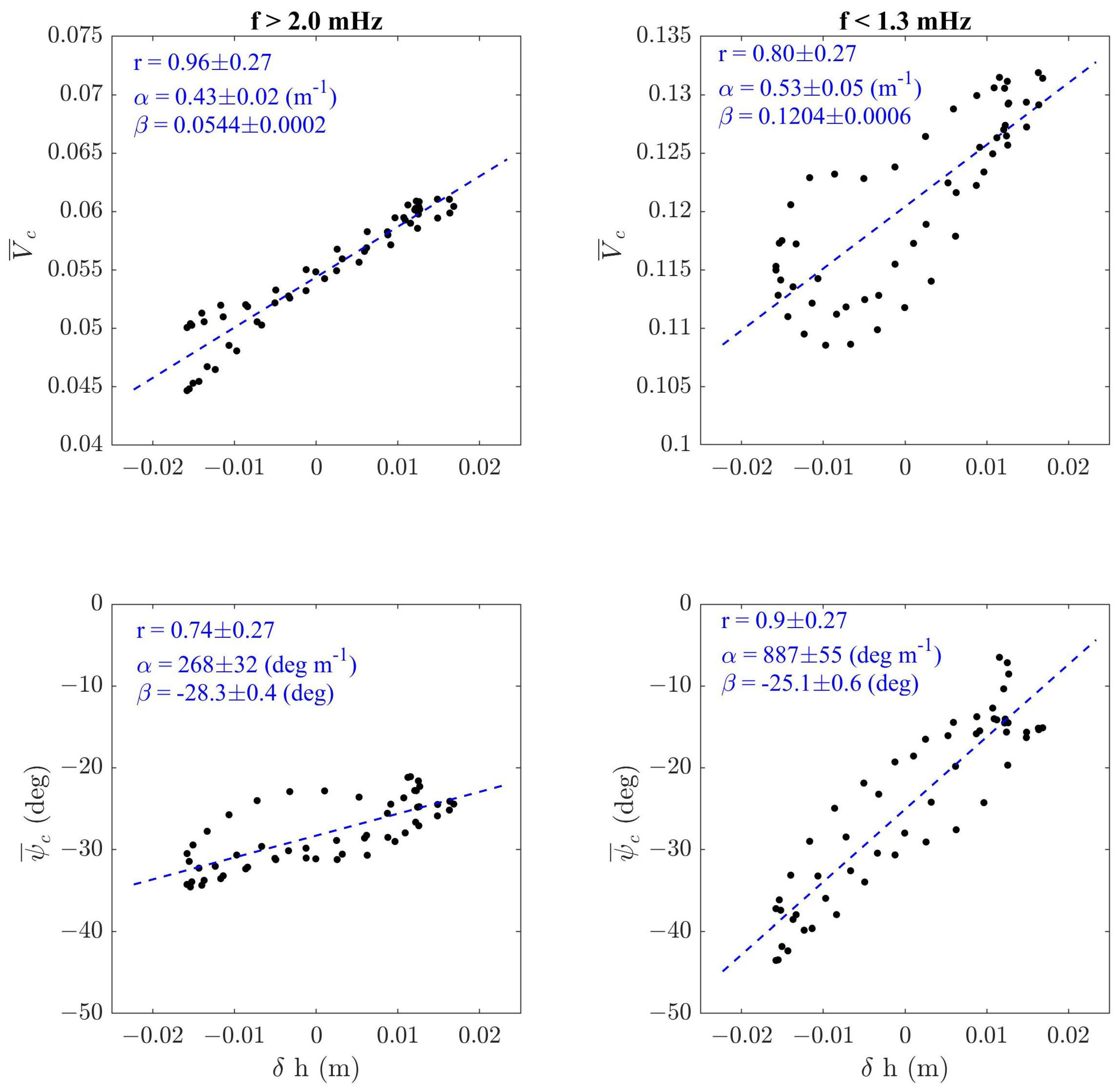
| Tidal Mode | Period (Hours) | Obs. | G | SE | G | SE | G | SE |
| K2 | 11.967 | LMP | 0.450 | 0.011 | 0.304 | 0.007 | 0.157 | 0.003 |
| DUR | 0.529 | 0.011 | 0.593 | 0.008 | 0.171 | 0.003 | ||
| M2 * | 12.421 | LMP | 0.514 | 0.011 | 0.362 | 0.007 | 0.132 | 0.003 |
| DUR | 0.246 | 0.011 | 0.368 | 0.008 | 0.210 | 0.003 | ||
| N2 * | 12.658 | LMP | 0.184 | 0.011 | 0.043 | 0.007 | 0.043 | 0.003 |
| DUR | 0.117 | 0.011 | 0.103 | 0.008 | 0.074 | 0.003 | ||
| K1 | 23.934 | LMP | 1.314 | 0.011 | 2.058 | 0.007 | 0.515 | 0.003 |
| DUR | 1.676 | 0.011 | 2.662 | 0.008 | 0.600 | 0.003 | ||
| P1 | 24.066 | LMP | 1.987 | 0.011 | 2.440 | 0.007 | 0.775 | 0.003 |
| DUR | 2.189 | 0.011 | 3.136 | 0.008 | 0.725 | 0.003 | ||
| O1 * | 25.819 | LMP | 0.431 | 0.011 | 0.080 | 0.007 | 0.125 | 0.003 |
| DUR | 0.380 | 0.011 | 0.140 | 0.008 | 0.097 | 0.003 |
| S2 (Day) [S2 (Night)] | M2 (Day) [M2 (Night)] | (M2 − M2)/M2 | ||||
|---|---|---|---|---|---|---|
| Geomag. Field Component | LMP | DUR | LMP | DUR | LMP | DUR |
| 5.1 [0.93] | 8.70 [0.69] | 0.59 [0.50] | 1.72 [0.25] | |||
| 8.4 [0.83] | 26.30 [0.60] | 0.44 [0.37] | 1.42 [0.40] | |||
| 2.8 [0.43] | 6.30 [0.48] | 0.09 [0.15] | 0.89 [0.20] | |||
Publisher’s Note: MDPI stays neutral with regard to jurisdictional claims in published maps and institutional affiliations. |
© 2022 by the authors. Licensee MDPI, Basel, Switzerland. This article is an open access article distributed under the terms and conditions of the Creative Commons Attribution (CC BY) license (https://creativecommons.org/licenses/by/4.0/).
Share and Cite
Regi, M.; Guarnieri, A.; Lepidi, S.; Di Mauro, D. Signature of Tidal Sea Level in Geomagnetic Field Variations at Island Lampedusa (Italy) Observatory. Remote Sens. 2022, 14, 6203. https://doi.org/10.3390/rs14246203
Regi M, Guarnieri A, Lepidi S, Di Mauro D. Signature of Tidal Sea Level in Geomagnetic Field Variations at Island Lampedusa (Italy) Observatory. Remote Sensing. 2022; 14(24):6203. https://doi.org/10.3390/rs14246203
Chicago/Turabian StyleRegi, Mauro, Antonio Guarnieri, Stefania Lepidi, and Domenico Di Mauro. 2022. "Signature of Tidal Sea Level in Geomagnetic Field Variations at Island Lampedusa (Italy) Observatory" Remote Sensing 14, no. 24: 6203. https://doi.org/10.3390/rs14246203
APA StyleRegi, M., Guarnieri, A., Lepidi, S., & Di Mauro, D. (2022). Signature of Tidal Sea Level in Geomagnetic Field Variations at Island Lampedusa (Italy) Observatory. Remote Sensing, 14(24), 6203. https://doi.org/10.3390/rs14246203






